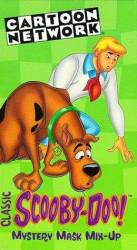Other mistake: When Fred hears footsteps, he says "Into the closet." But the closet has stairs and passageways inside.
Other mistake: When Shaggy is on the ground after being struck on the head by a vase, the inside of Scooby's eyes are brown instead of white.
Other mistake: When the gang are reading the book in the library, the page they are on says "2", despite the fact that they are halfway through the book.







Answer: During most episodes of "Scooby Doo, Where Are You?," the gang often split up to explore the latest haunted mansion or abandoned windmill or deserted amusement park. Scooby and Shaggy would generally end up together, Velma would often go off alone, and Daphne would frequently go exploring with Fred. It seemed to be a running theme in the "Scooby Doo" cartoons that Daphne was perpetually flirting with Fred. Fred, however, always seemed much more obliviously preoccupied with finding the next clue, foiling Daphne's amorous intentions. I have always been under the impression that the Scooby-Doo gang was a pretty sexually ambiguous group. More than a few people have suggested that athletic, well-coiffed, ascot-wearing Fred, and bookish Velma were early archetypes of gay/lesbian teens. The show existed in a time when several cartoons suggested sexual ambiguity in its characters: Effete Snagglepuss, a repeatedly drag-wearing Bugs Bunny (who even appeared in TV's first same-sex wedding with phallic rifle-toting Elmer Fudd), prim and polite gophers Mac and Tosh, Peppermint Patty, Marcie, Schroeder and Linus from the "Peanuts" cartoons. But whether or not any then subversive homosexual undertones were ever intended in any of the characters, the oft-paired Daphne and Fred never seemed able to get their relationship beyond the lukewarm stage, much to Daphne's apparent chagrin.
Michael Albert